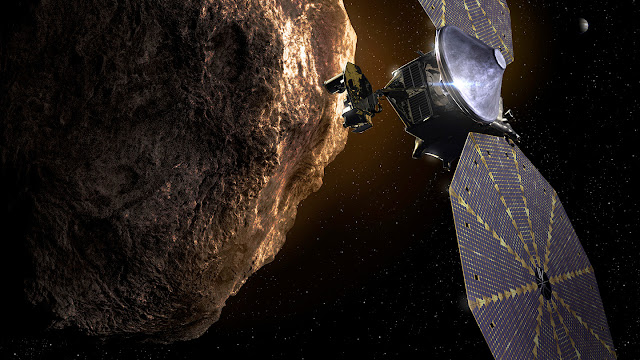 |
| Illustration of Lucy at a Trojan. Credit: NASA |
Launch Date: October 16, 2021Launch Site: Space Launch Complex-41 at Cape Canaveral Florida, United StatesLaunch Vehicle: Atlas V (V401 AV-096)Mission Type: FlybyTargets: Main-Belt asteroids and Jupiter TrojansDimensions: 14.25 Meters, by 12.4 Meters, by 2.78 MetersMass: 1550 Kilograms (Including Propellant)Build your own Lucy spacecraft out of LEGO here.
Make a paper model of the Lucy spacecraft here.
Lucy is NASA's ongoing mission to study the Trojan asteroids. Lucy's mission proposal originally planned to visit 7 asteroids, but the number has risen since then. Lucy will be able to visit so many different asteroids, thanks to a complex orbital trajectory, and multiple gravity assists.
The Mission So Far
Lucy is named after the famous Lucy skeleton. This skeleton belongs to the ancient human ancestor Australopithecus afarensis, and is one of the most complete skeletons of its kind. This skeleton got its name from the Beatles song "Lucy in the Sky with Diamonds," which was playing during the dig for the skeleton. After being selected along with the Psyche mission on January 4, 2017, construction began on the spacecraft.
Lucy's main mission is to learn about the Trojan asteroids, which orbit in gravitationaly stable points infront of, and behind, Jupiter. Several other asteroids have been added to the itinerary since, with a current total of 11 targets.
Lucy launched onboard an Atlas V rocket in October of 2021. Shortly after, the spacecraft suffered a malfunction of one of its solar arrays. Lucy's solar panels unfold like a paper fan, but one of them failed to latch properly. Fortunately this isn't life threatening for the mission, and the spacecraft should be just fine.
Lucy made a gravitational assist of Earth a year after its launch, on October 16, 2022, and that put the spacecraft on an orbit that goes past Mars. In early 2023, a second main belt asteroid was selected as a mission target. Later named Dinkinesh, Lucy flew by the asteroid on November 1, 2023. After its flyby of Dinkinesh, Lucy discovered a moon, which turned out to be the first contact binary found orbiting an asteroid.
The spacecraft will make another gravity assist of Earth on December 12, 2024. This will put Lucy on a trajectory towards Donaldjohanson, a main-belt asteroid named after the Lucy fossil's discoverer.
The flyby Donaldjohanson will take place on April 20, 2025. In 2027, Lucy will visit the L4 Trojans. Eurybates and its moon Queta, on August 12, 2027. Polymele and its currently unnamed moon on September 15, 2027. Leucus on April 28, 2028. And Orus on November 11, 2028.
After Lucy's third Earth gravity assist, it will visit the L5 Trojans. The spacecraft will fly by the binary system Patroclus and Menoetius on March 2, 2033. Currently these are the only planned targets in the L5 Trojan swarm, but more could be added in the future. Lucy will get there in 2033, completing its primary mission. However, it is possible that the spacecraft could live on to commit another flyby, if its in good condition, and a target can be found crossing its orbital path.
Even if more targets aren't added, the Lucy spacecraft will continue to alternate between the two Trojan swarms for 100,000 years.
Resources on the Lucy mission can be found here.
The Targets
Date Discovered: November 4, 1999Designation: 153830 Dinkinesh (1999 VD57)Class: Main Belt AsteroidRadius: 395 MetersRotational Period: 52.67 HoursOrbital Period: 1185.01 Days (3.24 Years)Moons: 1
Date Discovered: November 1, 2023Designation: I DinkineshClass: Contact Binary MoonletRadius: 110 Meters (Average)Rotational Period: 52.67 Hours?Orbital Period: 52.67 Hours?
Date Discovered: March 2, 1981Designation: 52246 Donaldjohanson (1981 EQ5)Class: Main Belt AsteroidRadius: 1.95 KilometresRotational Period: N/AOrbital Period: 1343.55 Days (3.68 Years)Moons: N/A
Date Discovered: September 19, 1973Designation: 3548 Eurybates (1973 SO)Class: Jupiter TrojanRadius: 31.94 KilometresRotational Period: 8.71 HoursOrbital Period: 4341.44 Days (11.89 Years)Moons: 1 (Queta)
Date Discovered: November 17, 1999Designation: 15094 Polymele (1999 WB2)Class: Jupiter TrojanRadius: 31.94 KilometresRotational Period: 5.86 HoursOrbital Period: 4309.01 Days (11.8 Years)Moons: 1 ("Shaun")
Date Discovered: October 12, 1997Designation: 11351 Leucus (1997 TS25)Class: Jupiter TrojanRadius: 17.08 KilometresRotational Period: 18.58 DaysOrbital Period: 4461.91 Days ( 12.22 Years)Moons: N/A
Date Discovered: November 9, 1999Designation: 21900 Orus (1999 VQ10)Class: Jupiter TrojanRadius: 25.41 KilometresRotational Period: 13.45 HoursOrbital Period: 4236.53 Days (11.6 Years)Moons: 1* (Candidate Only)
 |
| Hubble Image of Patroclus and Menoetius. Credit: HST/SwRI |
Date Discovered: October 17, 1906Designation: 616 Patroclus (A906)Class: Jupiter Trojan BinaryRadius: 70.18 KilometresRotational Period: 4.28 DaysOrbital Period: 4341.28 Days (11.89 Years)Moons: Binary of Menoetius
Date Discovered: September 22, 2001Designation: I MenoetiusClass: Jupiter Trojan BinaryRadius: 55.9 KilometresRotational Period: 4.28 DaysOrbital Period: 4341.28 Days (11.89 Years)Moons: Binary of Patroclus

















Comments
Post a Comment